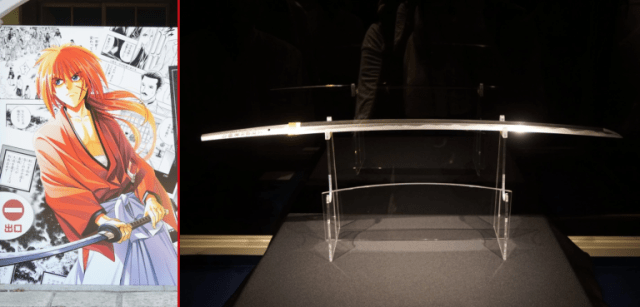
The sakabato’s journey brings it to Japan’s eastern capital, just like the anime swordsman’s did.
Himura Kenshin, protagonist of the Rurouni Kenshin anime/manga, famously wields a reverse-edged sword called a sakabato. The reason why is pretty easy to see from a storytelling perspective: Being unsharpened along the regular cutting edge for a katana lets Kenshin swing his sakabato with speed and strength in duels without drawing blood or killing his opponent. Having the inner edge sharpened, though, also provides a constant temptation to resort to deadly violence, and a means by which to show Kenshin’s honorable resolution in overcoming it as part of his path to redemption after years as a feared killer.
In real life 19th-century Japan, however, people in the market for a sword didn’t have the luxury of choosing a weapon that sacrificed sharpness in order to accentuate their troubled personal backstory, and so no real-world sakabato existed. Well, at least none existed until recently, when Japanese swordsmith Kanekuni Ogawa created one, called the Sakabato Shinuchi (meaning “Sakabato Truly Forged”)
▼ Kanekuni Ogawa
Based in the town of Seki, which has been known for its swordsmiths for centuries, Ogawa is so talented that he, personally, has been awarded the title of “important tangible cultural property” by the city. Upon the sword’s completion, it was exhibited in the Meijimura historical building park in Aichi Prefecture, in connection with Rurouni Kenshin being set in the Meiji period of Japanese history.
Now, though, just as the emperor of Japan moved from Kyoto to Tokyo in the Meiji period, so too is the Sakabato Shinuchi coming to the capital, where it will be displayed from April 24.
Even for those who’ve never read the manga or watched the anime (Ogawa himself had never seen either before taking on the project), the Sakabato Shinuchi is a striking piece, and has a singular beauty among Japanese swords. Because its blade is on the other side of where it would be on a normal katana, the real-life sakabato also has completely unique hamon (tempering marks), with the undulation being more prevalent along the inner curve of the flat.
▼ Sakabato Shinuchi, during its display at Meijimura
As is customary for swords in Japan, the Sakabato Shinuchi will be displayed without a handle. This is done because the nakago (the part of the hilt that extends into the handle) is where Japanese swordsmiths inscribe their names, though in the case of the Sakabato Shinuchi, Ogawa has instead carved the death poem of Arai Shakku, the smith who forged Kenshin’s sakabato in the anime, since that’s what’s on the nakago in the source material.
The sword will be displayed as part of the travelling Ruruni Kenshin Exhibition, celebrating the franchise’s 25th anniversary. The Tokyo exhibition will take place from April 24 to June 7 at Gallery AaMo, part of the Tokyo Dome City complex adjacent to Tokyo Dome, with tickets available online here.
Event information
Rurouni Kenshin Exhibition / るろうに剣心展
Venue: Gallery AaMo / ギャラリー アーモ
Address: Tokyo-to, Bunkyo-ku, Koraku 1-3-61
東京都文京区後楽1丁目3−61
Website
Source: Yahoo! Japan News/Oricon News via Otakomu, Rurouni Kenshin Exhibition website
Photos ©SoraNews24
● Want to hear about SoraNews24’s latest articles as soon as they’re published? Follow us on Facebook and Twitter!